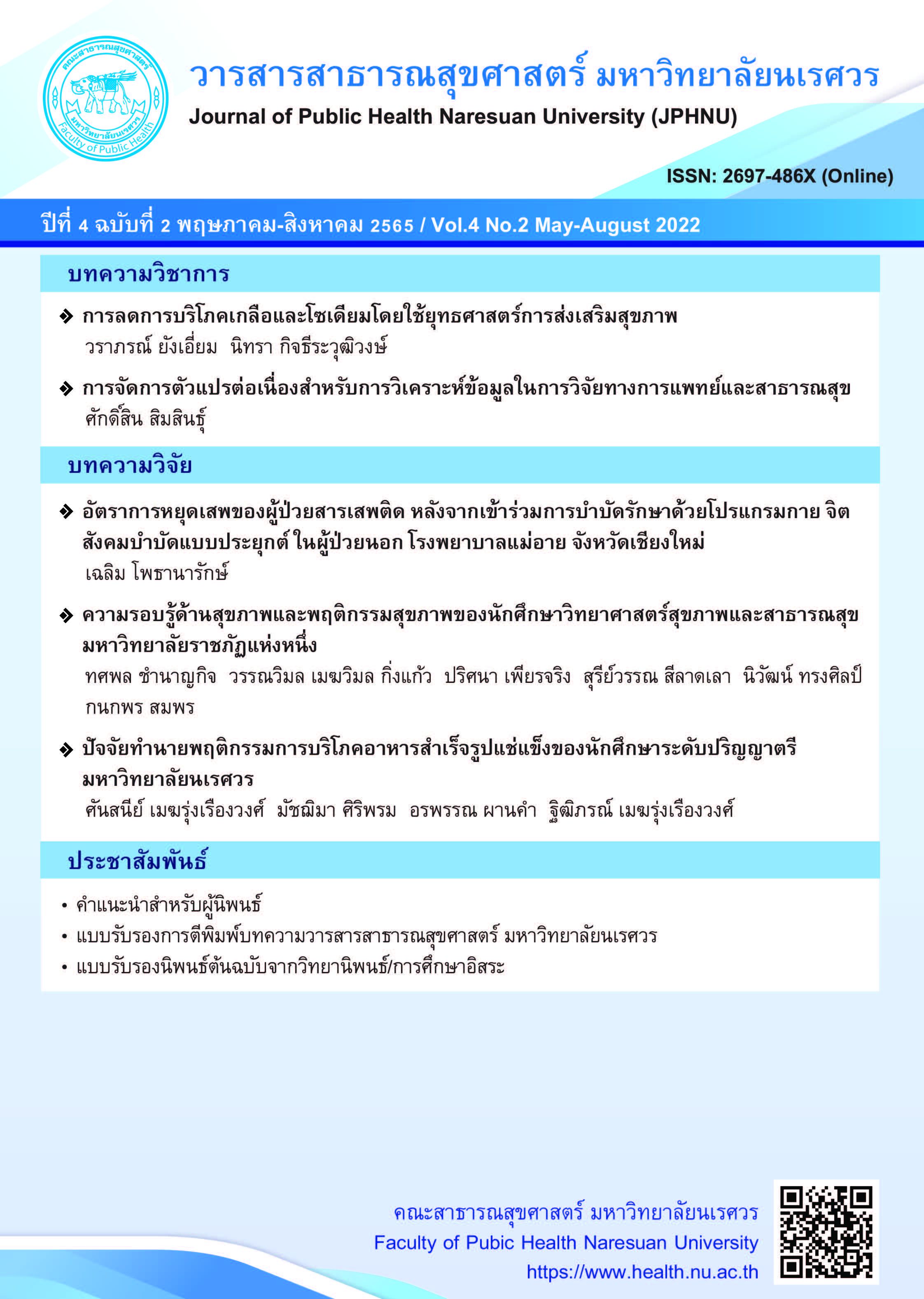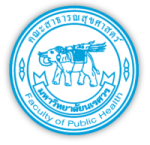Health literacy and health behaviors among health sciences and public health students at a Rajabhat University
Keywords:
Health literacy, Health behaviors, Health sciences and public health studentsAbstract
Health literacy is a cognitive and social skill for accessing information and understanding health information of individual which can be implement, including advising personal health, family, and the community to promote healthy behavior. This cross-sectional study aimed to investigate the level of health literacy and health behaviors, and explore the relationship between health literacy and health behaviors according to the principles of 3 A 2 S health behaviors (Ar-harn = Food, Aok-kam-lung-kai = Exercise, Ar-rom = Emotion, Soub-buri = Smoking and Su-ra = Alcohol). The sample consisted of 327 students from the cluster of health sciences and public health in a Rajabhat University which was selected through a stratified random sampling. Data were collected by using self-administrated questionnaire comprising of 3 parts as follows: part 1 demographic data, part 2 health literacy in relation to 3 A 2 S, and part 3 health behaviors regarding to 3 A 2 S. Cronbach's alpha coefficient of the questionnaire part 2 and 3 were calculated, obtained 0.94 and 0.95. Data were collected from March to April 2022 and analyzed by descriptive statistics and Pearson's correlation coefficient.
The findings revealed that the sample group had health literacy at a very good level of 56.0% and health behaviors at a good level of 46.2%. In addition, it was found that there were significant positive relationships between health literacy and health behaviors (r= 0.14, p-value < 0.001). The results of this study could be employed in planning of promoting health literacy and health behaviors modification according to the 3 A 2 S among the students from the cluster of health sciences and public health in a Rajabhat University.
References
Boonmun, T. (2021). Factors affecting to health literacy among village health volunteers in Sukhothai Province. Thesis of Master of Public Health, Naresuan University, Phitsanulok. (in Thai)
Chinapong, S., & Kaosanit, P. (2020). Health literacy, health behaviors, and physical activities of North Bangkok University undergraduate students. Journal of Health, Physical Education and Recreation, 46(2), 56-67. (in Thai)
Department of Health Service Support. (2020). Assessment health literacy and health behavior. Retrieved July 1, 2022, from http://www.hed.go.th/linkHed/437 (in Thai)
Health Education Division. (2021). Planning and assessment group; 2021- Summary of health literacy and behavior assessment results health of the people in the target group (working and school age). Retrieved January 17, 2022, from http://www.hed.go.th/linkHed/437 (in Thai)
Kaeodumkoeng, K. (2018). Health literacy access, understand and application. (2nd ed.). Bangkok: Amarin. (in Thai)
Kaeodumkoeng, K. (2021). Health literacy processes, practices, evaluation tools. (1st ed.). Bangkok: Ideol Digital Print. (in Thai)
Kancham, S., Wongsawang, N., Suwanm, T., Sitthimongkon, T., & Techai, S. (2019). Health literacy and health behaviors among students at Uttaradit Rajabhat University. Academic Journal of Science and Applied Science, 1, 33-43. (in Thai)
Krejcie, R. V., & Morgan, D. W. (1970). Determining sample size for research activities. Educational and Psychological Measurement, 30, 607-610.
Lattanand, K., & Ninwatcharamanee, C. (2019). Health literacy of nursing students at Boromarajonani College of Nursing Bangkok. Journal of Boromarajonani College of Nursing, Bangkok, 35(1), 277-289. (in Thai)
Mullan, J., Burns, P., Weston, K., McLennan, P., Rich, W., Crowther, S. et al. (2017). Health literacy amongst health professional University students: A study using the health literacy questionnaire. Educ Sci, 7(2), 54. Retrieved July 1, 2022, from https://www.mdpi.com/2227-7102/7/2/54
Panchuwong, T., & Banlikitkul, T. (2010). Fatigue and fatigue management during the fundamentals of nursing practicum for nursing students at the Thai Red Cross College of nursing. Thai Red Cross Nursing Journal, 3(1), 59-71. (in Thai)
Phongsakchat, P., Sompee, P., Kaeonoi, A., & Mekanantawat, K. (2019). Health literacy and health behaviors based on local wisdom of nursing students, Borommarajonani College of Nursing Nopparat Vajira. Journal of Health Science, 28, 20-32. (in Thai)
Rakpanusit, T., Jeenmuang, N., & Khoyneung, N. (2018). Factors related to health promoting behavior among undergraduate university student, Prince of Songkla University, Pattani Campus. ASJ PSU, 29(3), 170-178. (in Thai)
Suriyawong, W., Songkham, W., Sripetchwandee, N., & Kawil, K. (2019). Health literacy and health promotion behaviors among student nurse Chiang Mai University. Journal of Nursing Science & Health, 42(3), 96-106. (in Thai)
Tanasugarn, C., & Roma, W. (2018). The concept of a well-rounded health organization. (1st ed.). Nonthaburi: Department of Health. (in Thai)
World Health Organization. (1998). Health literacy and health promotion: Definitions, concepts and examples in the Eastern Mediterranean Region. Individual Empowerment Conference Working Document. 7th Global Conference on Health Promotion Promoting Health and Development. Nairobi, Kenya: World Health Organization.
World Health Organization. (2019). Global action plan for the prevention and control of NCD 2013-2020. Geneva: World Health Organization.
Downloads
Published
How to Cite
Issue
Section
License
Copyright (c) 2022 Journal of Public Health Naresuan University

This work is licensed under a Creative Commons Attribution-NonCommercial-NoDerivatives 4.0 International License.
The published article is copyrighted by the Journal of Public Health and Health Sciences Research.
The statements that appear in each article in this academic and research journal are the personal opinions of each author and are not related to Naresuan University and other faculty members in the university. Responsibilities regarding each article are the responsibility of each author.






